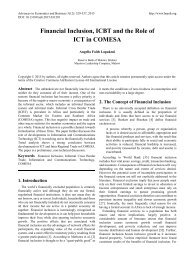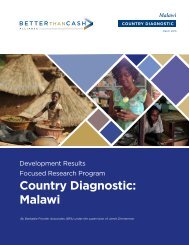FD
gvti301SEaf
gvti301SEaf
You also want an ePaper? Increase the reach of your titles
YUMPU automatically turns print PDFs into web optimized ePapers that Google loves.
Lin, 04/4/2016<br />
found, two-thirds of the increase in debt during credit booms<br />
is, on average, subsequently reduced (IMF, 2013). If debt<br />
reduction in the euro area follows a similar path, firms have<br />
a long way to go in paying off debt, which could significantly<br />
delay a recovery in investment. Households in some euro area<br />
countries also suffer from high debt. Although household<br />
debt-to-GDP ratios have fallen 10 to 20 percentage points<br />
in high-debt countries, they remain significantly above their<br />
preboom levels, raising the prospect that debt will continue<br />
to inhibit consumer spending for some time.<br />
Insuring against shocks<br />
The baseline projection for the euro area continues to foresee<br />
subdued growth and inflation over the medium term. This reflects<br />
the impact of high unemployment, heavy debt burdens,<br />
and weak balance sheets that suppress demand and of longstanding<br />
structural weaknesses—such as a rigid labor market<br />
and an overprotected product market—that depress potential<br />
growth. Moreover, these factors are intertwined: lower potential<br />
growth makes it harder to bring down debt, while high<br />
unemployment and low investment hurt capital accumulation<br />
and reduce potential growth.<br />
Subdued medium-term prospects leave the euro area susceptible<br />
to negative shocks—such as another global slowdown—that<br />
could push economies into stagnation because<br />
they are hamstrung by their inability to respond through<br />
macroeconomic policies (such as cutting taxes and/or<br />
increasing spending). Moreover, unaddressed problems from<br />
the crisis could amplify these shocks. For instance, markets<br />
could reassess the sustainability of countries with high debt;<br />
subsequent higher borrowing costs would in turn raise the<br />
risk of a debt-deflation spiral.<br />
An economic model used to simulate the effect of shocks<br />
on the euro area makes several assumptions: with interest<br />
rates at zero, monetary policy cannot do much more to<br />
stimulate the economy, and high debt limits the use of fiscal<br />
policy beyond the operation of automatic stabilizers such as<br />
unemployment benefits.<br />
In this scenario, several developments—such as an increase<br />
in geopolitical tension, a political crisis within the European<br />
Union, or lowered growth expectations—could trigger a sudden<br />
drop in investor confidence. Lower equity prices would<br />
follow, along with a 25 percent decrease in investment growth<br />
(from about 2 percent to 1.5 percent annually) relative to the<br />
baseline projection. This would raise public-debt-to-GDP<br />
ratios differently across the euro area, depending on a particular<br />
economy’s level of debt. Market concerns about debt<br />
sustainability would also increase more for indebted countries.<br />
Sovereign and corporate interest rates would rise by a<br />
full percentage point in Greece, Ireland, Italy, Portugal, and<br />
Spain—similar to the increase in the Spanish 10-year sovereign<br />
bond yields during late June and July 2012.<br />
These results highlight the vulnerability of the euro area<br />
to lower growth. By 2020 the euro area output level would<br />
be nearly 2 percent lower than the baseline projection. As<br />
a result, it would take three to four more years (relative to<br />
the baseline projection) for economic output to reach its<br />
Chart 3<br />
Behind the curve<br />
A shock to investment in the euro area makes the<br />
economies grow far more slowly than in baseline<br />
projections.<br />
(cumulative growth loss by 2020, percent)<br />
Euro area<br />
Germany<br />
France<br />
Italy<br />
Spain<br />
Portugal<br />
Greece<br />
Ireland<br />
–4 –3 –2 –1 0<br />
Source: Author’s estimates.<br />
Note: The results are based on an economic model used to simulate the effect of<br />
shocks—such as an increase in geopolitical tension, a political crisis, or lower<br />
expectations for growth—on the euro area. The model assumes fewer additional effects<br />
from monetary policy and constraints on fiscal policy beyond automatic stabilizers such<br />
as unemployment benefits. The baseline is the projected path of economic growth under<br />
current conditions.<br />
full potential. Borrowing costs would increase, especially<br />
in Greece, Ireland, Italy, Portugal, and Spain. The unemployment<br />
rate and public-debt-to-GDP ratios would also<br />
increase. Inflation rates would be lower, pushing the euro<br />
area closer to deflation in the near term (see Chart 3).<br />
Reducing vulnerability<br />
Weak medium-term prospects and limited potential to use<br />
economic policy to stimulate their economies leave the euro<br />
area vulnerable to shocks that could lead to a prolonged period<br />
of low growth and low inflation. Insuring against such<br />
risks would require a broad and balanced set of policies. Such<br />
policies should go beyond the easing of monetary policy that<br />
has been the main tool to stimulate euro area economies.<br />
Banks, the bulwark of the European financing system, need<br />
to be put under stricter supervision and must make faster<br />
progress in getting bad loans off their books so that they can<br />
lend more. Policymakers must facilitate the restructuring of<br />
unhealthy but viable firms to reduce debt and allow them<br />
to begin to invest again. Authorities also need to undertake<br />
structural reforms to improve productivity and raise potential<br />
growth and, when they are able, to increase spending to boost<br />
demand, which will promote economic growth. ■<br />
Huidan Lin is an Economist in the IMF’s European Department.<br />
This article is based on the author’s IMF working paper, No. 16/9, “Risks of<br />
Stagnation in the Euro Area.”<br />
References:<br />
International Monetary Fund (IMF), 2013, “Indebtedness and<br />
Deleveraging in the Euro Area,” Euro Area Policies, 2013 Article IV<br />
Consultation—Selected Issues Paper, IMF Country Report 13/232<br />
(Washington).<br />
———, 2015, “Where Are We Headed? Perspectives on Potential<br />
Output,” World Economic Outlook, Chapter 3 (Washington, April).<br />
54 Finance & Development June 2016














